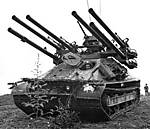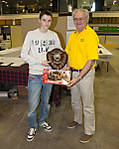Hairspray TechniqueIím back and with another update although I wasnít sure Iíd make it this week. I spent a busy weekend at the IPMS Ireland Nationals and was quite chuffed to win a medal in the competition. Unfortunately I also contracted a pretty build cold that built up over the weekend so that by Sunday evening I was feeling terrible. Iím still trying to shake the cough.

During my last update I said that I was going to apply a matt coat to the T-80 before proceeding. I wanted to do this in order to seal in my previous attempt at using hairspray. I used Vallejo Matt Varnish straight from the bottle and applied it lightly with a brush.
In the picture above you may notice that around the engine deck, the drivers hatch and other areas of the tank that the grey is showing through. Thatís forced contrast at work, providing a sense of shadow and depth to the model. Although in this case it is very slight and it wonít last long once the white goes on.

The hairspray that Iím using is Wella Silvikrin, apparently it produces a natural hold for... I really donít care. Iím using it because it was already sitting in my bathroom. Otherwise I would have bought the cheapest possible brand I could find, possibly one without
Parfum as an ingredient. Once I applied this I was engulfed in a sickly-sweet cloud that set my cough off something fierce.

I applied the hairspray in two quick passes and at a distance, not because of scented clouds of death but rather to ensure I did not build up a thick coat on the tank. It seems to me to be all too easy to coat a model very thickly with hairspray and lose detail in the process. It goes without saying that you
do not touch the model just after application unless you fancy a nicely detailed and ridged fingerprint marring your work. Hairspray is effectively a form of glue used the combat the wind and the 1980ís so caution all round. Thankfully it does dry very fast but Iíd still leave it for a couple of hours just to be sure.
The hairspray also goes down very glossy, as you can see, and one might be persuaded to try it out as an alternative to gloss varnish or Future.
Do not be fooled though as the entire purpose behind the hairspray is that it reacts to heat. With a little hot water the hairspray comes right off taking the overlaying coat of paint with it. Many decal softening and setting solutions get hot as part of their process and would undoubtedly affect the hairspray resulting in a mess.

I gave the hairspray about an hour and thirty minutes to dry out before I gingerly poked it with a toothpick just to be sure it wasnít still tacky. The
camouflage scheme that I intend to use, which may well by fictional as that is a picture of an RC model, has most of the tank in white with green ribbons snaking across the vehicle. So, I broke out the Blu Tack and spend quite a while laying down the ribbons, just taking my time as I went. I pulled the Blu Tack out into long thin sections and then used a toothpick to flatten the edges to ensure I wouldnít get any overspray or bleeding.

I used Revell Aqua Color White for the white and I misted in over the model in successive coats as I didnít really want a bright white or a full looking white. The way I envisage this camouflage scheme is that the tank started out solid green with the white added later, possibly in a field depot, and as such is more easily damaged. I also didnít bother painting the bottom of the tank in white as I presume the crew wouldnít either for the same reason; no-one is going to see it.

Next came the fun part of slowing removing the Blu Tack and checking out the results. Of course some time has passed in order to let the white cure properly. The results, I think, are fantastic. There are only one or two small cases of overspray and because of what Iíll be doing next that is easily fixed. This is only my second time painting camouflage using the airbrush and Iím becoming more grateful for it with each successful use.
The Revell acrylics airbrush very well but they do need to be thinned a bit before use. A mixture of water and their own of brand thinner will sort that out. A little Vallejo Drying Retarder can be added to the mix to ensure it the paint doesnít dry out as it passes through the airbrush.
For the next step, chipping of the hairspray, youíll need three things:
1. A tub or bottle of warm water but nothing too hot either. This process needs to be conducted delicately, at least in 1/72nd scale, or youíll quickly go too far.
2. A brush with short, sharp, stiff bristles in order to chip the paint. The best idea is to take one of your older banjaxed brushes and clip the bristles down close to the handle.
3. Patience. Think about where you want to do the chipping and how you want the tank to look at the end and then carefully proceed.

I decided to go for some generally large paint flaking across the tank with more worn down wear and tear around the hatches, storage boxes and side skirts. I had a lot of fun doing this although I realise I couldíve gone for a more subtle approach. I like to think it works though.
Basically what you do is take your paintbrush and dip it in the water and then dip it onto some paper towel to take away the excess water because what you donít want is water running all over the model. Next pick an area you want the chipping to appear and either begin gently stabbing it with the brush or rubbing it. It really depends on the effect youíre going for. Either way the warm water causes the hairspray to melt taking the overlaying coat of paint with it. The reason I stated patience above is because it is very easy to go on a chipping frenzy and suddenly youíre left with Tankenstein or Aerozilla. The beauty of using this technique though is you can be as subtle as you like and just produce some scratches here and there if you wish; itís all down to personal choice really.
There are a few alternatives to using the hairspray technique. You can use salt weathering to produce a more random look of paint flecking. Alternatively you can brush down small areas of liquid mask and then remove them when required to produce the desired effect. I imagine any liquid mask would work but I know that AK interactive brought out something recently especially for doing just this.
My next update will involve detail painting various parts of the T-80 so that is where it will start coming to life. However first I think Iíll put down another matt coat and seal the hairspray in again just for safety.
Thanks for watching.






































